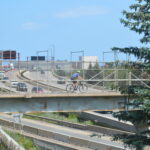Northern Lights Express Passenger Rail: Stimulus or Boondoggle?
There have been a number of posts on PDD in the past regarding the Northern Lights Express passenger rail project, which would create a 155-mile train corridor connecting Duluth to Minneapolis. With Congressman Jim Oberstar’s loss to Chip Cravaack in Tuesday’s election, and Cravaack’s stated lack of support for the project, the subject of the NLX seems worth revisiting.
However, I’d like to provide some special guidelines for commenting on this post, because we’ve seen in the past that there are some pretty passionate supporters and opponents of this project, and its pros and cons tend to get lost in personal attacks and partisan silliness.
So, let’s try a little experiment. What I’d like to see is three different types of comments.
1) Simple links to news and information related to this subject, without any commentary whatsoever.
2) Comments labeled “Pro” at the beginning, which list one good thing about the project.
3) Comments labeled “Con” at the beginning, which list one negative thing about the project.
Keep it brief, resist the urge to respond to other people’s comments, resist the urge to make multiple pro or con comments, resist the urge to bash Cravaack or Oberstar, resist the urge to comment about these guidelines.
Ready. Set. Go.
Recommended Links:
Leave a Comment
Only registered members can post a comment , Login / Register Here












60 Comments
Paul Lundgren
about 14 years agoLojasmo
about 14 years agoNick
about 14 years agoClaire
about 14 years agoDanny
about 14 years agoChad
about 14 years agoShane
about 14 years agoTony
about 14 years agoSam
about 14 years agoClaire
about 14 years agojim
about 14 years agoedgeways
about 14 years agozra
about 14 years agoSam
about 14 years agoBarrett Chase
about 14 years agoHot Shot
about 14 years agoadEm
about 14 years agoGerman Chris
about 14 years agodigit3
about 14 years agoTerry G.
about 14 years agoBret
about 14 years agovicarious
about 14 years agoGeorge
about 14 years agobrian
about 14 years agoTerry G.
about 14 years agoTimK
about 14 years agoadam
about 14 years agobaci
about 14 years agoSanchette
about 14 years agoResol
about 14 years agoW.T.F
about 14 years agotodobrillante
about 14 years agoian
about 14 years agospy1
about 14 years agoPaul Lundgren
about 14 years agowildgoose
about 14 years agoian
about 14 years agochadp
about 14 years agoClaire
about 14 years agoEirik R
about 14 years agoShane
about 14 years agojt
about 14 years agoFarragut
about 14 years agoJoel S
about 14 years agoNotShane
about 14 years agoAdem
about 14 years agoSlingFade
about 14 years agoClaire
about 14 years agospy1
about 14 years agoWill
about 14 years agoSlingFade
about 14 years agoGerman Chris
about 14 years agoClaire
about 14 years agoDanny G
about 14 years agornarum
about 14 years agoWill
about 14 years agoGerman Chris
about 14 years agoWill
about 14 years agoResol
about 14 years agoHendo
about 14 years ago